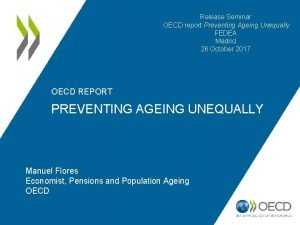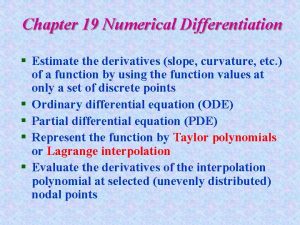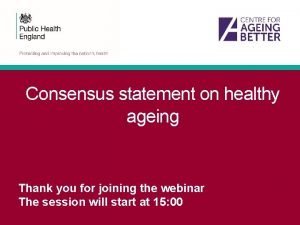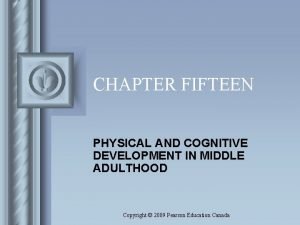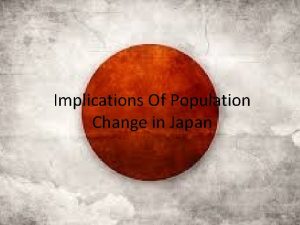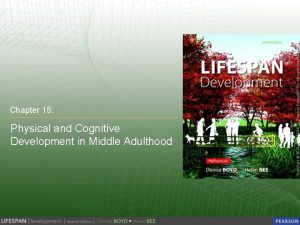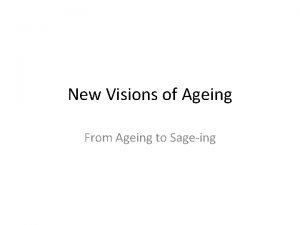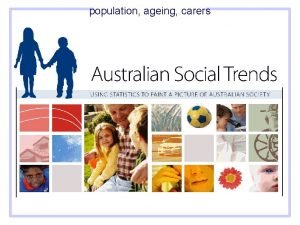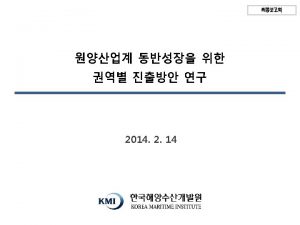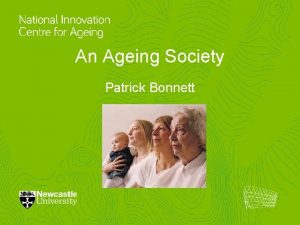Release Seminar OECD report Preventing Ageing Unequally FEDEA






















- Slides: 22

Release Seminar OECD report Preventing Ageing Unequally FEDEA Madrid 26 October 2017 OECD REPORT PREVENTING AGEING UNEQUALLY Manuel Flores Economist, Pensions and Population Ageing OECD

MAIN FINDINGS OF THE REPORT WITH A FOCUS ON SPAIN

Outline of the talk 1. How the two mega-trends of population ageing and rising inequalities have been developing and interacting within and across generations 2. How disadvantage becomes entrenched: compounding inequalities over the life course 3

Outline of the talk 1. How the two mega-trends of population ageing and rising inequalities have been developing and interacting within and across generations 2. How disadvantage becomes entrenched: compounding inequalities over the life course 4

The share of healthy life years in remaining life expectancy at the age of 50 has been broadly stable Life expectancy and healthy life years at age 50 in 2004 and 2014, men Selected countries Source: OECD (2017) - Preventing Ageing Unequally based on Eurostat data. 5

How has income inequality evolved across generations? Income Gini by cohort and age groups, selected OECD countries Source: OECD (2017) - Preventing Ageing Unequally based on Luxembourg Income Study data. 6

Income improvements across generations are losing steam on average… Age-cohort pattern of real disposable income, OECD average, 2010 USD PPP Source: OECD (2017) - Preventing Ageing Unequally based on Luxembourg Income Study data. 7

…with varying trends across countries Difference (%) in average real income in the 50 -54 age bracket, 1960 s versus 1950 s birth cohorts, selected countries Source: OECD (2017) - Preventing Ageing Unequally based on Luxembourg Income Study data. 8

Poverty risks have shifted from the old to the young on average Relative poverty rates by age group since the mid-1980 s in 18 OECD countries OECD average Source: OECD (2017) - Preventing Ageing Unequally based on OECD Income Distribution Database. 9

Real income growth was faster for the older age groups in Spain (as for the OECD) Change in relative income of 60 -64 vs 30 -34 year olds; mid-1980 s to mid-2010 s Selected countries % 5 E-12 4 E-12 3 E-12 2 E-12 1 E-12 0 -1 E-12 -2 E-12 a str Au lia m ny da 19 tes a D a do t m g C r S C Kin ited OE Ge d ite Un n U a an ly Ita ain p S ce ark m n De n Fra Source: OECD (2017) - Preventing Ageing Unequally based on OECD Income Distribution Database. 10

Employment rates across generations have risen among women and have dropped among men Women Men All OECD average by birth decade 100% 80% 60% 40% 1930 1940 1950 1960 1970 1980 Note: The chart displays the average estimated cohort effects across countries from a specification which for each country includes age and cohort effects. The graph uses the cohort series based on a reference age of 50 -54 years old. Source: OECD (2017) - Preventing Ageing Unequally based on Luxembourg Income Study data. 11

Education premium in employment rates has dropped among women Differences in employment rates between the high and low educated are shrinking among younger Spanish women Career average of the difference in percentage points for three selected generations Selected countries Source: OECD (2017) - Preventing Ageing Unequally based on OECD estimates using various micro data sets. 12

Outline of the talk 1. How the two mega-trends of population ageing and rising inequalities have been developing and interacting within and across generations 2. How disadvantage becomes entrenched: compounding inequalities over the life course 13

Early childhood is the starting point for lasting disadvantage • Inequalities in health and socioeconomic status (the SES-health gradient) originate early in life and accumulate over the life course • Childhood circumstances have direct and indirect effects on later life • Childhood is a critical period (nutritional shortage early in life can produce permanent brain damage and stunting) • Childhood is a sensitive period (easier to learn a foreign language as a kid than as an adult) 14

The mechanics of working-age disadvantage: links between health and labour market outcomes Health worsens with age Share of people reporting bad health by age, gender, and education 15 Note: OECD calculations from microdata on 24 OECD countries.

People in bad health work less and earn less at all ages 16 Note: OECD calculations from microdata on 24 OECD countries.

Bad health reduces men’s lifetime earnings substantially (and less so for women) Impact of health on lifetime labour earnings by education levels Average across countries, 100 = Lifetime earnings for a man in good health with a medium education level Note: OECD calculations from microdata on 24 OECD countries. 17

Large pass-through from wage to pension inequality Change in the Gini index of pensions for a 1 percentage point increase in the Gini index of wages Selected countries Note. Simulations are based on a common earnings distribution across countries and a shift from a wage Gini of 0. 35 to 0. 38. 18

Inequalities in retirement: making the work-toretirement transition Changes in life expectancy at age 65 and in the average of labour market exit since 1975, in years Source: OECD calculations. Labour market exit age data are based on the results of national labour force surveys, the European Union Labour Force Survey and, for earlier years in some countries, national censuses. Life expectancy data stem from OECD Health Statistics and are based on Eurostat data and national sources. 19

Large inequalities in labour market exit age exist Average effective age of labour market withdrawal by education, 2016 Selected countries Source: OECD calculations. Labour market exit age data are based on the results of national labour force surveys, the European Union Labour Force Survey and, for earlier years in some countries, national censuses. Life expectancy data stem from OECD Health Statistics and are based on Eurostat data and national sources. 20

The age gradient in employment rates differs substantially across countries Employment rates of workers aged 55 -59, 60 -64 and 65 -69 Selected countries in 2016 Source: OECD (2017) – OECD Employment Outlook 2017. 21

OECD REPORT PREVENTING AGEING UNEQUALLY manuel. flores@oecd. org www. oecd. org/els Twitter: @OECD_Social 22
 Preventing ageing unequally
Preventing ageing unequally Derivatives of unequally spaced data
Derivatives of unequally spaced data Do not be unequally yoked
Do not be unequally yoked Nocoderm
Nocoderm Extended release vs sustained release
Extended release vs sustained release What is controlled release
What is controlled release Medieval theatre makeup
Medieval theatre makeup Healthy ageing
Healthy ageing Greater manchester ageing hub
Greater manchester ageing hub Denny's model of physical and cognitive ageing
Denny's model of physical and cognitive ageing Japanese ageing population
Japanese ageing population Micro theories of aging
Micro theories of aging Denny's model of physical and cognitive ageing
Denny's model of physical and cognitive ageing Ageing suit
Ageing suit Sageing
Sageing Buck boost transformer seminar report
Buck boost transformer seminar report Sixth sense technology seminar report
Sixth sense technology seminar report Under water wind mill seminar report
Under water wind mill seminar report Pulse detonation engine seminar report
Pulse detonation engine seminar report Screenless display technology ppt
Screenless display technology ppt Parasitic computing seminar report
Parasitic computing seminar report Mobile note taker
Mobile note taker Underwater windmill seminar report
Underwater windmill seminar report
